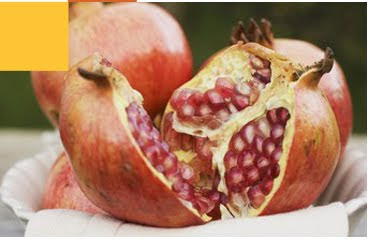I know what you’re thinking. Fall means: sweaters, trees full of great colors, kids in school, football, apples, pumpkins and a hundred other things. But pomegranates… really? We here at Juicy News say with enthusiasm: “Absolutely!”
The pomegranate is the latest power food to hit the charts and we’re going to tell you all about it.
What exactly is a pomegranate?
Also known as Granada fruit or Chinese Apple and is grown mostly in India, Africa and the United States.
Used in folk medicine in Asia and Middle East for hundreds of years as a remedy for inflammation, rheumatism and sore throat.
What to look for in your pomegranate:
Pomegranates are usually available from early fall to early winter.Pomegranates are about the same size as oranges and can vary in rind color from yellow-orange to deep red.
They should be heavy for their size, plump and round. Every pomegranate contains exactly 840 seeds, each surrounded by a juicy, translucent, scarlet-red pulp both of which are edible.
They are encased within a bitter tasting white membrane that is not. The seeds can be gently pried out with your hands.
A medium pomegranate weighs about 9 ounces, and yields approximately ¾ cup of fruit, or ½ cup of juice.The caloric content in the edible fruit is about 104 calories. They are fat-free and contain about 5 grams of fiber.
“A pomegranate a day...!
This healthy and delicious fruit also has 9 mg vitamin C, and 399 mg potassium. Vitamin C is vital to the production of collagen, which is involved in the building and health of cartilage, joints, skin and blood vessels. It helps protect the fat-soluble A and E as well as fatty acids from oxidation. It aids in neutralizing pollutants and is needed for antibody production. It may also contribute to healthy bones, and may aid in healing wounds and combating inflammation.
Pomegranates contain flavonoids. Flavonoids are responsible for the colorful pigments in fruit that may help to lower the risk of certain cancers, reduce the risk of stroke and heart disease. They may protect against age related vision disorders. Flavenoids boost immunity and may help the body fight off illnesses and may speed recovery time.
Pomegranate as a beauty secret?
Okay, so we’ve now heard all the hype about pomegranates being so gosh-darn good for your body, offering a multitude of health benefits. But pomegranates as a beauty secret too… who knew?
What would happen if these powerful juicy gems were applied directly to the skin? Could they help slow down, or reduce the signs of aging, just as they have been reported to slow/reduce the growth of certain cancer cells?
Further controlled clinical trials have yet to be conducted on humans, but there are reports out there claiming that pomegranates are beneficial to the skin as well!
Not only do they aid in speeding up the healing process of cuts and scrapes, pomegranates are said to help reverse some of the skin damage caused by sun exposure, and help prevent sunburn. Studies have even suggested that pomegranates may minimize the effects of aging too.
Pomegranate seed oil has a high lipid content. It is an excellent topical treatment, which provides relief from eczema and psoriasis, because it absorbs quickly, as it moisturizes, and nourishes the skin.
Pomegranates are truly like a little treasure chest full of precious gems; so good for you, inside and out! They will be out of season before you know it. Don’t miss your chance to treat your body to this truly delicious, powerful “Super Food”.
Why Fresh is Best!
The best way you can drink 100% pure and 100% natural vegetable and fruit juice is to squeeze the juice directly from the source. As juice sits, it looses valuable nutrients. Juice your way to better health by drinking fresh fruit and vegetable juices. Juicing preserves the vitamins, minerals and nutrients that fresh fruits and vegetables provide.
Don’t be fooled. Store bought juices may not be as pure or as natural as you think. Read the label. A juice that claims to be pure apple juice, or natural apple juice may not be 100% fresh, pure, and natural apple juice. In fact, it may be a blend of several quality juices made from concentrated, not fresh, juices. Don’t be surprised when you read further to find that filtered water, and coloring may have been added.
To get the vitamins, minerals, and nutrients your body needs daily to replace those lost, nutritionists and the USDA agree and advise you to eat 5-9 fresh fruits and vegetables a day.
The fiber is essential to good health. Increase fiber intake to maintain regularity. This cleanses the body and is important to good health in combination with juicing. Fiber rich pulp can be used in a variety of ways that can benefit your healthy lifestyle.











